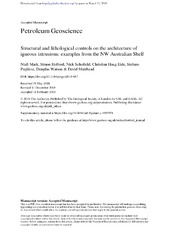Structural and lithological controls on the architecture of igneous intrusions: examples from the NW Australian Shelf
Mark, Niall; Holford, Simon P.; Schofield, Nick; Eide, Christian Haug; Pugliese, Stefano; Watson, Douglas; Muirhead, David
Peer reviewed, Journal article
Accepted version

View/
Date
2020Metadata
Show full item recordCollections
- Department of Earth Science [1096]
Original version
https://doi.org/10.1144/petgeo2018-067Abstract
Rift-related magmatism resulting in widespread igneous intrusions has been documented in various basins, including the Faroe Shetland Basin (UK), the Voring and Møre basins (Norway), and along the NW Shelf of Australia. Seismic mapping, combined with fieldwork, has resulted in greater understanding of subsurface intrusive plumbing systems but knowledge of emplacement style and the mechanisms by which intrusions propagate is limited. The interpretation of a 3D seismic dataset from the Exmouth Sub-basin, NW Shelf of Australia, has identified numerous igneous intrusions where a close relationship between intrusions and normal faults is observed. These faults influence intrusion morphology but also form pathways by which intrusions have propagated up through the basin stratigraphy. The steep nature of the faults has resulted in the intrusions exploiting them and thus manifesting as fault-concordant, inclined dykes; whereas in the deeper parts of the basin, intrusions that have not propagated up faults typically have saucer-shaped sill morphologies. This transition in the morphology of intrusions related to fault interaction also highlights how dykes observed in outcrop may link with sills in the subsurface. Our interpretation of the seismic data also reveals subsurface examples of bifurcating intrusions with numerous splays, which have previously only been studied in outcrop.